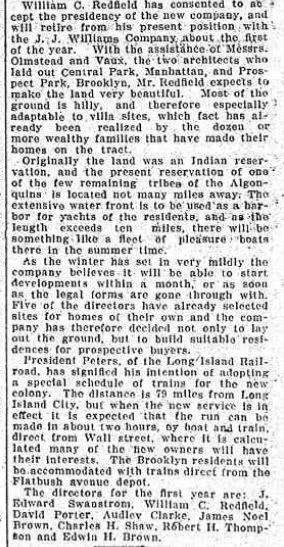I have no doubt he tried to get more water frontage along Great Peconic Bay , and if he could have built 22 or 26 holes, he probably would have taken more! It is probably a bit more attractive than Sebonac Bay and my impression is that not having Peconic frontage was a practical compromise.
Once the clubhouse site set the routing, he just couldn't stretch the course far enough to make more use of Great Peconic Bay. He does lament the burning of SI just a few years later, and had he either gotten more money, thought to use a temporary clubhouse (as would be done today) or forseen that fire, I am sure there would be a few more holes along the water than ended up occurring.
However these decisions might have been worked out given today's sensibilities, for CBM
the quality of the golf course was the main criteria, not the scenery. In this regard, while views were nice, a seaside location was a necessity because only a seaside (or sea-approximate) location could provide the proper conditions (such as the proper soil, undulations, winds, etc.) for ideal golf. So while views were undoubtedly a bonus, they were not a driving consideration.
Also, while the location of the Shinnecock Inn was obviously a factor that CBM considered, I think we are kidding ourselves if we pretend he would have have had no other option but to utilize the Inn. CBM was reportedly an extremely successful and wealthy man around this time, and most of his founders were as wealthy or wealthier. Had utilizing all of the Peconic Bay frontage been the best move for golf, do you really think that CBM and his millionaire crowd could not have worked it out? After all, once they decided to to build the clubhouse they managed to work it out, did the not? Were building along as much water-view property as possible what was really driving CBM, it seems that with his recourses and friends he could have probably worked that out.
I think a more likely scenario is that the land running south along Bullshead Bay best suite what he had in mind especially given some of the features he identified, and the land extending toward the Inn not only worked very for the course he had in mind, it also allowed him to put off dealing with a clubhouse and let him focus on his main priority --creating his ideal course.
Or it could be that the developer was reluctant to part with all of the Peconic Bay front property, and thought it might someday have a high value for development.
_____________________
I had posted that 1873 Atlas before, but I understand why you didn't realize this. It was about a month ago, the first time Mike took us through the wild goose chase about his mystery third site. Between then and this time he agreed that the October articles referred to the Sebonack Neck area, before circling back again after after I challenged him to consider how that impacted his main claims.
That is the problem with Mike's methodology of adamantly pursuing a claim, then jumping away from it when it doesn't go his way, then returning to it later. People forget the facts and how Mike's fantasies didn't line up with them, and we have the same discussions over and over again.
For example, here is another article, this one from the December 28, 1905 Brookly Eagle, describing the land and development plans. Note that according to the article the "main highroad" to Southhampton and SHGC also ran through the property, and the Golf Grounds station already existed. Yet we've wasted our time debating these very same issues.


Obviously, Mike has been wasting or time. We've covered all this ground - whether Good Ground or Golf Ground - before.
Oh! I'll take the highroad and
Ye'll take the lowroad,
And I'll be in Shinnecock afore ye;
But Mike'll be back te Good Ground
He'll never leave the sand
O' the bonnie, bonnie banks of the Canal.